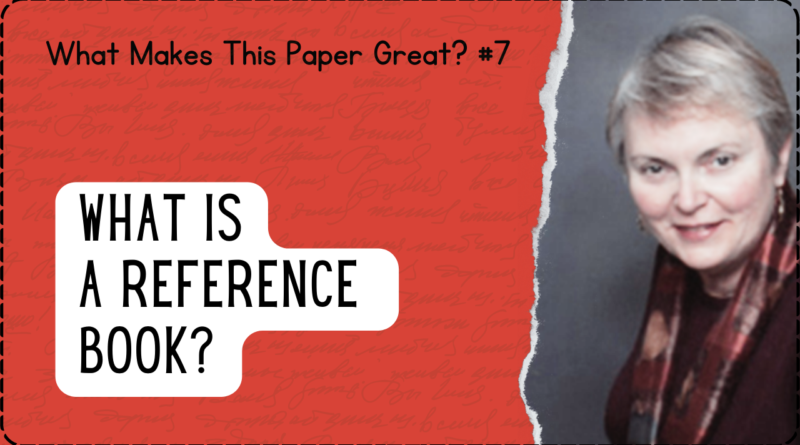An Unpopular Video That Bridges Certain Divides in Information Science
A (Paper) and Video That Bridge Certain Divides in Information Science
Jenna Hartel
Of the 48 videos about Information Science at my YouTube channel, INFIDEOS, my favorite has received the least attention. In fact, it is downright unpopular compared to others. That’s too bad, because I believe this video bridges certain divides in Information Science and demonstrates a less fragmented and more holistic potential of our field. I am speaking of episode #7 of the What Makes This Paper Great? series on Marcia Bates’ 1979 paper, What Is a Reference Book?: A Theoretical and Empirical Analysis. Granted, there may be some resistance to revisiting a paper written so long ago, during a very different Information Age.
Nevertheless, Bates’ article and my video feature an interplay of perspectives that have grown apart since the paper’s publication in the late 1970s. On the one hand, our field focuses upon the properties of information artifacts such as documents, their aggregates in literatures, and the information systems that contain them. Specialties such as information retrieval, knowledge organization, and bibliometrics are examples therein. On the other hand, Information Science is concerned with how humans need, seek, and use information, which is well-developed in the information behavior area, and increasingly seen through social and cultural lenses. This bifurcation is not only in my imagination, for White and McCain’s epic co-citation analysis of Information Science described the field as having two faces, “…a relative emphasis on literatures as objects of study…[and] a relative emphasis on people or users.” (White & McCain, 1998, p. 350). Each of these domains enacts distinct methodologies and scholars are usually at home in one or the other.
—The paper What is a Reference Book? and its video honor both perspectives and demonstrate their symbiotic relations.—
The paper What is a Reference Book? and its video honor both perspectives and demonstrate their symbiotic relations. In her paper, Bates begins on the artifactual or technical side of Information Science and analyzes the organization of reference books, leading to a new definition based upon the concepts of record, field, and manual file. (These are excellent terms to introduce to newcomers, and are shown just below.) Later in the paper she pivots to explain how these structures enable a certain kind of human information behavior common to reference books, namely, scanning and looking-up information, shown further below. Reading this paper as a doctoral student in the early 2000s was a Eureka! moment for me, providing my first glimpse of the entire information equation, and establishing an enduring awareness of both sides.


Likewise, my video brings the material and human dimensions of information to life. It takes the viewer into Bates’ conception of the reference book, with a dictionary as an example, illustrating records, fields, and files, shown just below. This is followed by vivid animations of people (and many leaping gazelles!) interacting with reference books, leveraging the unique information structures they contain. My video also contains a socio-cultural interlude that goes beyond Bates’ paper. Taking culinary recipes as a case study (Hartel, 2007), viewers are shown how information is socially constructed over generations, in relation to cultural trends and changing technologies, shown further below. These historical dynamics are accompanied by classical music and cast as a “dance between information and society.”


Educators can use this video in any introductory courses of Information Science, to establish the complexity of information and the breadth of our field. Viewers could be prompted to watch for the interplaying perspectives. To generate discussion and self-discovery, students could be asked to discern which of the narratives attracts them the most, potentially helping initiates find their way into the information domain and its professions. In the video, Bates’ analysis of information’s structural and behavioral properties could even motivate an assignment. Students can be asked to analyze comparable structures within any information genre (e.g. a journal article or a business letter), and then, taking a longer and more socio-cultural view, articulate its “dance” with society.
With this posting, I hope one of the least popular videos at INFIDEOS gets more attention, thereby fortifying a more holistic and multi-perspective understanding of Information Science.
References
Bates, M. J. (1986). What is a reference book? A theoretical and empirical analysis. RQ, 26(1), 37–57.
Hartel, J. (2007). Information activities, resources, and spaces in the hobby of gourmet cooking. ProQuest Dissertations Publishing.
White, H., & McCain, K. W. (1998). Visualizing a discipline: An author co-citation analysis of information science, 1972-1995. Journal of the American Society for Information Science, 49(4), 327–355.
Cite this article in APA as: Hartel, J. (2022, May 26). An unpopular video that bridges certain divides in information science. Information Matters, Vol. 2, Issue 5. https://informationmatters.org/2022/05/an-unpopular-video-that-bridges-certain-divides-in-information-science/





